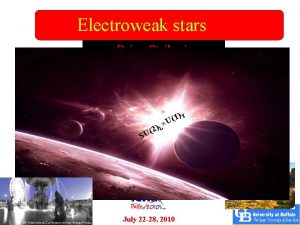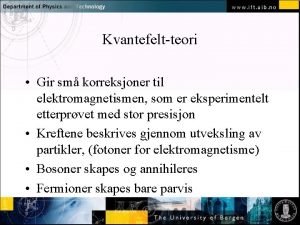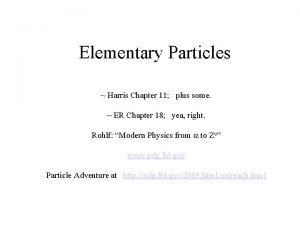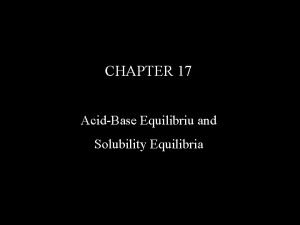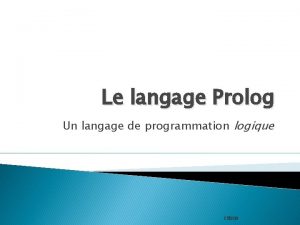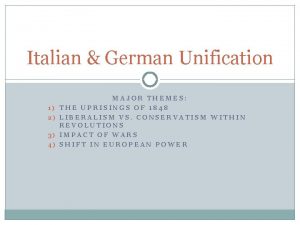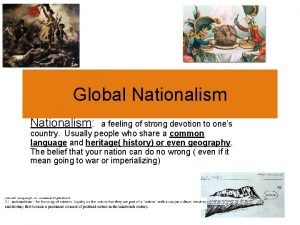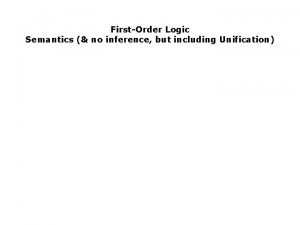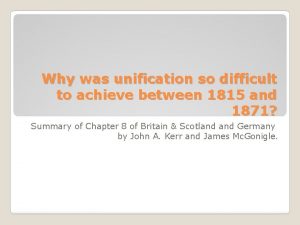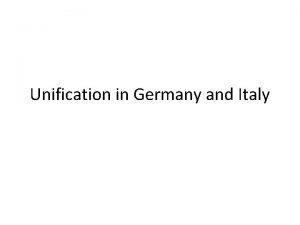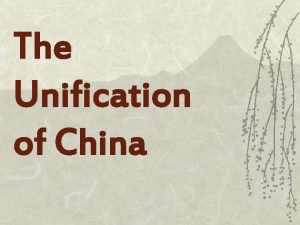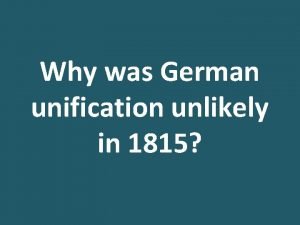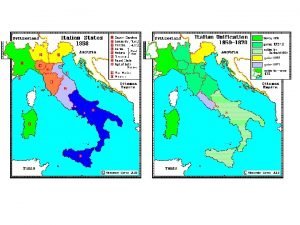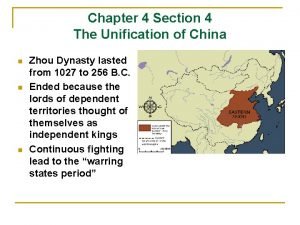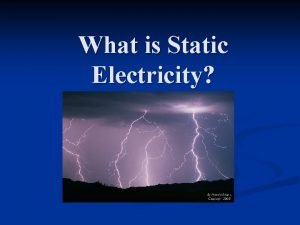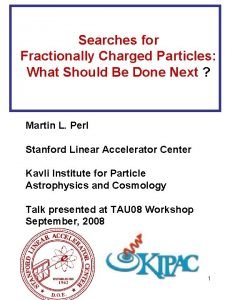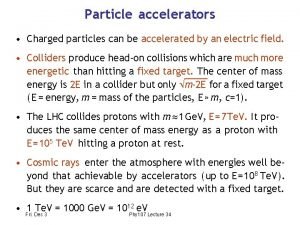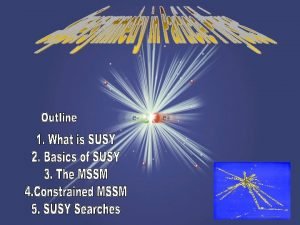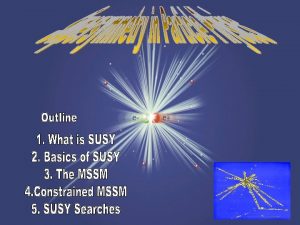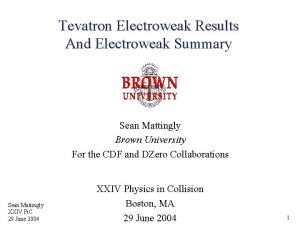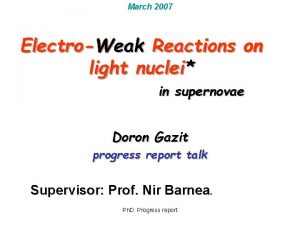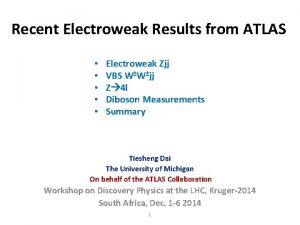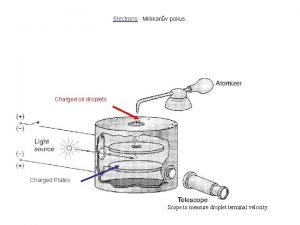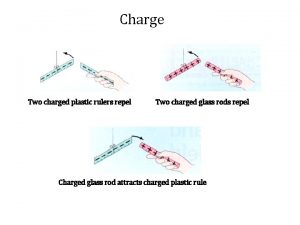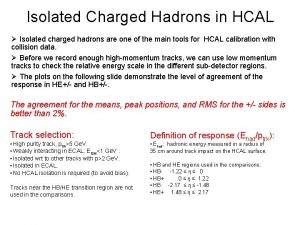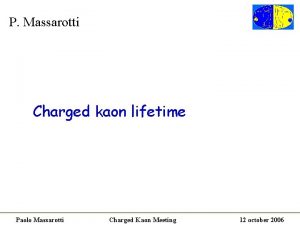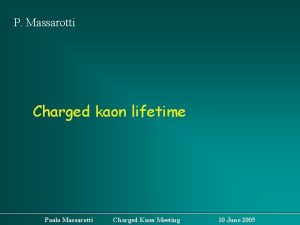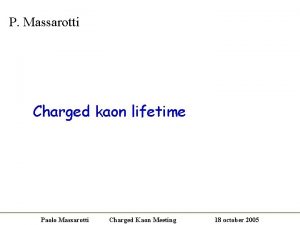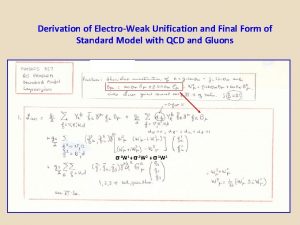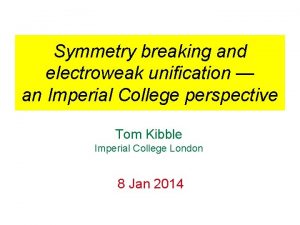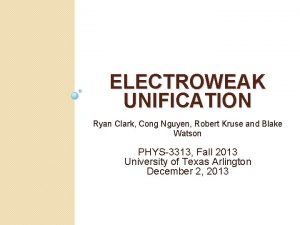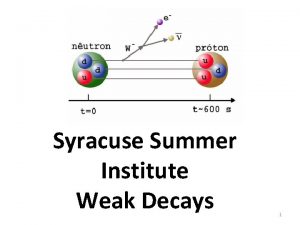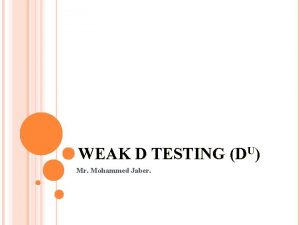Section IX Electroweak Unification Electroweak Unification Weak Charged



































- Slides: 35

Section IX Electroweak Unification

Electroweak Unification Ø Weak Charged Current interactions explained by W exchange. Ø W bosons are charged, couple to photon. 2 diagrams (+interference) s. WW (pb) Consider e+ e+ + e e Ø Cross-section DIVERGES at high energy Ø Divergence cured by introducing Z 0 Ø Extra diagram e+ e Ø Only works if g, W , Z 0 couplings are related ELECTROWEAK UNIFICATION 221

The GWS Model The Glashow, Weinberg and Salam model treats EM and WEAK interactions as different manifestations of a single UNIFIED ELECTROWEAK force (Nobel Prize 1979) Basic Idea: Start with 4 massless bosons {W+, W 0, W } and B 0. The neutral bosons MIX to give physical bosons (the particles we see), i. e. the W , Z 0 and g. Physical fields: W+, Z 0, W and A (photon) WEAK MIXING ANGLE W , Z 0 “acquire” mass via the HIGGS MECHANISM. 222

The beauty of the GWS model is that it makes EXACT predictions of the W and Z 0 masses and couplings with ONLY 3 free parameters. Couplings given by aem and g W Z 0 Masses given by GF and From Fermi theory If we know {aem, GF, sin } (from experiment) everything else is FIXED. 223

Evidence for GWS Model Ø Discovery of Neutral Currents (1973) The process was observed. ONLY possible Feynman diagram (no W diagram) Indirect evidence for Z 0 Ø Direct Observation of W and Z 0 (1983) First DIRECT observation in collisions at leptons. Ge. V via decays into Ø Precision Measurements of the Standard Model (1989 -2000 ) LEP e+e- collider (see later) provided many precision measurements of the Standard Model. Ø Wide variety of different processes consistent with GWS model predictions and measure SAME VALUE of 224

The Weak NC Vertex All weak neutral current interactions can be described by the Z 0 boson propagator and the weak vertices: Z 0 Z 0 STANDARD MODEL WEAK NC LEPTON VERTEX STANDARD MODEL WEAK NC QUARK VERTEX +antiparticles Ø Z 0 NEVER changes type of particle Ø Z 0 NEVER changes quark flavour Ø Z 0 couplings are a MIXTURE of EM and WEAK couplings and therefore depend on (exact form treated in Part III Particles course) 225

Examples: 226

Summary of Standard Model Vertices ELECTROMAGNETIC STRONG WEAK CC WEAK NC (QCD) (QED) g WZ 0 g +antiparticles g W- Z 0 227

Drawing Feynman Diagrams A Feynman diagram is a pictorial representation of the matrix element describing particle decay or interaction To draw a Feynman diagram and determine whether a process is allowed, follow the FIVE basic steps: 1 Write down the initial and final state particles and antiparticles and note the quark content of all hadrons. 2 Draw the SIMPLEST Feynman diagram using the Standard Model vertices. Bearing in mind: - Similar diagrams for particles/antiparticles - NEVER have a vertex connecting a LEPTON to a QUARK - Only the WEAK CC vertex changes FLAVOUR within generations for leptons within/between generations for quarks 228

- Particle scattering Ø If all particles (or all antiparticles), only SCATTERING diagrams involved e. g. Initial state Final state Ø If particles and antiparticles, can have SCATTERING and/or ANNIHILATION diagrams e. g. 229

3 Check that the whole system CONSERVES - Energy, momentum (trivially satisfied for interactions) - Charge - Angular Momentum 4 Parity - CONSERVED in EM/STRONG interaction - CAN be violated in the WEAK interaction 5 Check SYMMETRY for IDENTICAL particles in the final state - BOSONS - FERMIONS Finally, a process will occur (in order of preference) via the STRONG, EM and WEAK interaction if steps 11 - 5 are satisfied. 230

Examples: 1. 2. 3. 4. 231

Experimental Tests of the Standard Model The Large Electron Positron (LEP) collider at CERN provided precision measurements of the Standard Model (1989 -2000). Designed as a Z 0 and W boson factory e+ e f = fermion Precise measurements of the properties of Z 0 and W bosons provide the most stringent test of our current understanding of particle physics. 232

LEP Ø LEP is the highest energy e+e- collider ever built. Ø Large = 27 km circumference Ø 4 experiments combined: 16, 000 Z 0 and 30, 000 W events France Switzerland 233

A LEP Detector: OPAL was one of the 4 experiments at LEP. Size = 12 m x 12 m x 15 m Muon Chambers Hadron Calorimter Tracking Chambers Electromagnetic Calorimeter 234

Particle Identification Different particles leave different signals in the various detector components allowing almost unambiguous identification. JET ge e : EM energy + track g : EM energy, no track m : track + small energy deposit + muon t : decay, observe decay products n : not detected Quarks: seen as jets of hadrons Hadrons: energy deposit+ track (charged only) Electron Photon Muon Pion Neutrino Jet 235

Typical Events 236

In the event, the tau leptons decay within the detector (lifetime ~ 10 -13 s). Here, and 237

The Z 0 Resonance Consider the process of Ø Previously, , only considered an intermediate photon Ø At higher energies also have the Z 0 exchange diagram (plus Z 0 g interference) (see pages 123 and 100) Ø The Z 0 is a decaying intermediate massive states (lifetime ~ 10 -25 s) BREIT-WIGNER RESONANCE Ø At the Z 0 diagram dominates. 238

239

BREIT-WIGNER formula for fermion-antifermion pair) (where is ANY Centre-of-mass energy with giving Ø GZ is the TOTAL DECAY WIDTH, i. e. the sum over the partial widths for different decay modes. 240

At the peak of the resonance : Hence, for ALL fermion/antifermion pairs in the final state Compare to the QED cross-section at 241

Measurement of MZ and GZ Mass of the Z 0, MZ Total decay width, GZ Peak cross-section, s 0 ) close to the peak shad [nb] Ø Run LEP at various centre-of-mass energies ( of the Z 0 resonance and measure Ø Determine the parameters of the resonance: One subtle feature: need to correct measurements for QED effects due to radiation from the e+e- beams. This radiation has the effect of reducing the centre-of-mass energy of the e+e- collision which smears out the resonance. ECM [Ge. V] 242

MZ measured with precision 2 parts in 105 Ø To achieve this required a detailed understanding of the accelerator and astrophysics! Tidal distortions of the Earth by the Moon cause the rock surrounding LEP to be distorted. The nominal radius of LEP changes by 0. 15 mm compared to radius of 4. 3 km. This is enough to change the centre-of-mass energy ! Ø Also need a train timetable ! Leakage currents from the TGV rail via lake Geneva follow the path of least resistance…using LEP as a conductor. Accounting for these effects (and many others): 243

Number of Generations Ø Currently know of THREE generations of fermions. Masses of quarks and leptons INCREASE with generation. Neutrinos are ~ massless (? ) Ø Could there be more generations ? e. g. Ø The Z 0 boson couples to ALL fermions, including neutrinos. Therefore, the total decay width, GZ, has contributions from all fermions with m f < MZ / 2 with Ø If there were a FOURTH generation, it seems likely that the neutrino would be light, and, if so would be produced at LEP Ø The neutrinos would not be observed directly, but could infer their presence from the effect on the Z 0 resonance curve. 244

At the peak of the Z 0 resonance A FOURTH generation neutrino would INCREASE the Z 0 decay rate and thus INCREASE GZ. As a result a DECREASE in the measured peak cross-sections for the VISIBLE final states would be observed. Ø Measure the cross-sections for all visible decay modes (i. e. all fermions apart from ) Examples: 245

Ø Have already measured MZ and GZ from the shape of the Breit. Wigner resonance. Therefore, obtain from the peak crosssections in each decay mode using Note, obtain from Ø Can relate the partial widths to the measured TOTAL width (from the resonance curve) where Nn is the NUMBER OF NEUTRINO SPECIES and Gnn is the partial width for a single neutrino species. 246

The difference between the measured value of GZ and the sum of the partial widths for visible final states gives the INVISIBLE WIDTH 2494 4. 1 Me. V 83. 7 0. 2 Me. V 84. 0 0. 3 Me. V 83. 9 0. 4 Me. V 1745. 3 3. 5 Me. V 497. 3 3. 5 Me. V In the Standard Model, calculate Therefore THREE generations of light neutrinos 247

Most likely that ONLY 3 GENERATIONS OF QUARKS AND LEPTONS EXIST In addition: Ø are consistent universality of the lepton couplings to the Z 0 Ø is consistent with the expected value which assumes 3 COLOURS – yet more evidence for colour 248

W+W- at LEP Ø e+e- collisions W bosons are produced in pairs. Ø Standard Model 3 possible diagrams: e+ e+ e+ e e e Ø LEP operated above threshold for W+W- production (1996 -2000) s. WW [pb] Ø Cross-section sensitive to the presence of the Triple Gauge Boson vertex 249

W+W- Decay at LEP In the Standard Model and couplings are equal. 3 FOR COLOUR EXPECT (assuming 3 colours): Branching fractions 10. 5% 43. 9% QCD corrections ~ 45. 6% 250

W+W- Events in OPAL 251

Measurement of MW and GW Ø Unlike , W boson production at LEP is NOT a resonant process Ø MW measured by reconstructing the invariant mass on an event-byevent basis. 4 -momenta 252

W Boson Decay Width In the Standard Model, the W boson decay width is given by -decay: LEP: Therefore, predict partial width: Total width is the sum over all partial widths: 3 FOR COLOUR IF the W coupling to leptons and quarks is EQUAL, and there are 3 colours: Compare with measured value (LEP): Ø Universal coupling constant Ø Yet more evidence for colour ! 253

Summary Now have 5 precise measurements of fundamental parameters of the Standard Model (at q 2=0) In the Standard Model, ONLY 3 are independent. Their consistency is an incredibly powerful test of the Standard Model of Electroweak Interactions ! 254
 Oppenheimer volkoff limit
Oppenheimer volkoff limit Electroweak lagrangian
Electroweak lagrangian Electroweak interaction
Electroweak interaction Electroweak interaction
Electroweak interaction Strong acid-strong base titration indicator
Strong acid-strong base titration indicator Weak acid and weak base reaction
Weak acid and weak base reaction Strong and weak bases
Strong and weak bases Prolog langage
Prolog langage Italy unification summary
Italy unification summary Chapter 23 lesson 3 nationalism unification and reform
Chapter 23 lesson 3 nationalism unification and reform What was the most serious obstacle to german unification?
What was the most serious obstacle to german unification? Germany before unification
Germany before unification Strong devotion
Strong devotion Germany before unification
Germany before unification Unification operating model
Unification operating model Fol unification
Fol unification Why did germany avoid “wounding austria too severely”?
Why did germany avoid “wounding austria too severely”? Why was italian unification difficult to achieve
Why was italian unification difficult to achieve German and italian unification compare and contrast
German and italian unification compare and contrast Unification of china
Unification of china Prolog unification
Prolog unification Obstacles to german unification
Obstacles to german unification Unification algorithm example
Unification algorithm example Germany before 1871
Germany before 1871 Gauge coupling unification
Gauge coupling unification Obstacles to italian unification
Obstacles to italian unification Unification of italy class 10
Unification of italy class 10 Italian risorgimento timeline
Italian risorgimento timeline National unification and the national state
National unification and the national state Stages of german unification
Stages of german unification The unification of china
The unification of china Static electricity
Static electricity New richmond school district skyward
New richmond school district skyward The search for fractionally charged particles has
The search for fractionally charged particles has Charged particles can be accelerated by
Charged particles can be accelerated by F=i(lxb)
F=i(lxb)
